In a world filled with constant communication, the art of having a meaningful conversation often gets overlooked.
In this article, we will explore 10 ways to have a better conversation.
These actionable steps will guide you towards creating connections that transcend surface-level interactions. Allowing you to truly engage with others and leave a lasting impact.
So, let’s dive in and discover the transformative power of these 10 ways to have a better conversation.
10 ways to have a better conversation
- Listen attentively
- Show empathy and understanding
- Cultivate curiosity
- Maintain a positive and respectful tone
- Avoid judgment and assumptions
- Practice reflection and self-awareness
- Be present in the conversation
- Practice effective storytelling
- Practice patience and tolerance
- Follow up and nurture relationships
Let’s delve into the 30 actionable steps that encompass the ten ways to have a better conversation.
Listen attentively
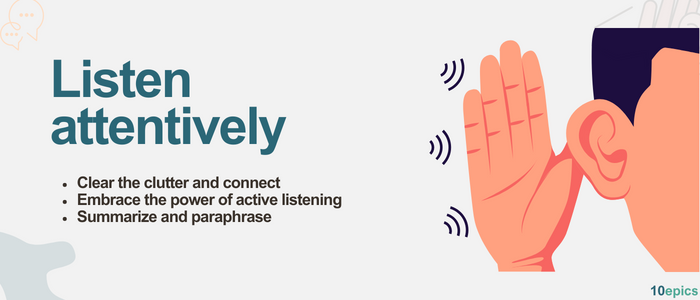
Step 1: Clear the clutter and connect
It’s crucial to eliminate the noise and truly engage with the person in front of you. Put away your phone, close those open tabs, and create a space that is solely dedicated to the conversation. By giving your undivided attention, you send a powerful message that the speaker’s words matter.
Step 2: Embrace the power of active listening
Maintain eye contact to establish a connection and let the speaker know that you’re fully present.
Nodding along and offering verbal cues like “I see” or “Go on” encourages them to continue sharing.
By practicing active listening, you create a safe and supportive environment that invites deeper conversation.
Step 3: Summarize and paraphrase
To ensure that you truly grasp the speaker’s message, take a moment to summarize and paraphrase their key points.
This not only demonstrates your attentiveness but also allows the speaker to confirm or clarify their thoughts.
By showing genuine interest and seeking clarification, you foster a sense of mutual understanding and make the conversation more enriching for both parties.
Show empathy and understanding
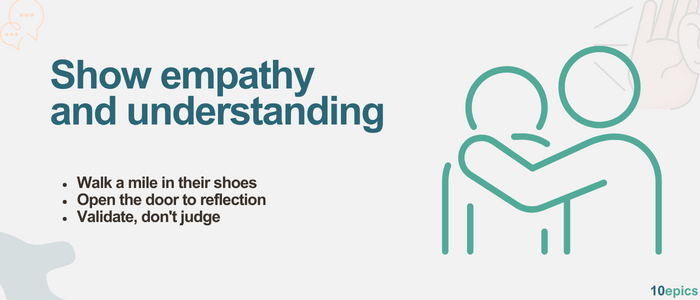
Step 4: Walk a mile in their shoes
To truly connect with the speaker, try to understand their perspective by putting yourself in their shoes. Empathy is the key here. Imagine their experiences, challenges, and emotions.
This exercise helps you gain a deeper appreciation for their point of view, fostering a genuine connection that transcends surface-level conversation.
Step 5: Open the door to reflection
Open-ended questions are the gateway to deeper conversations.
Instead of asking closed-ended questions that elicit simple “yes” or “no” responses, opt for questions that invite reflection and self-expression.
For example, ask, “How did that make you feel?” or “What led you to that decision?” These questions encourage the speaker to delve into their thoughts and emotions, allowing for more meaningful dialogue.
Step 6: Validate, don’t judge
In any conversation, it’s essential to create a safe space where the speaker feels heard and understood.
Validate their emotions and experiences without passing judgment. Acknowledge their feelings by saying things like, “I can understand why you might feel that way” or “It sounds like a challenging situation.” This validation fosters trust and opens the door for a more honest and authentic exchange of ideas.
Cultivate curiosity

Step 7: Thought-provoking questions
To ignite engaging conversations, ask thought-provoking questions that inspire curiosity and stimulate deeper thinking. Instead of settling for surface-level inquiries, dive into uncharted territories.
Encourage the speaker to explore new ideas, challenge assumptions, and share their unique perspectives.
By asking questions that spark intellectual curiosity, you invite a richer exchange of thoughts and experiences.
Step 8: The fuel for growth
Genuine curiosity is a powerful catalyst for personal and intellectual growth. Show a sincere desire to learn from others by actively seeking their insights and experiences.
Be genuinely interested in their stories, opinions, and expertise. By fostering an atmosphere of curiosity, you create an environment where diverse perspectives are celebrated and knowledge is shared.
Step 9: Mindset of a lifelong learner
Cultivate a mindset of a lifelong learner, recognizing that there is always something new to discover and learn from others.
Be willing to challenge your own beliefs and be open to changing your perspective based on new information.
Embracing a learner’s mindset not only enriches your conversations but also broadens your understanding of the world.
Maintain a positive and respectful tone

Step 10: Politeness and etiquette
In conversations, practicing good manners and etiquette is essential to create a positive and respectful atmosphere.
Avoid interrupting or talking over others, allowing them to express their thoughts fully.
Show patience and give everyone an opportunity to be heard. By valuing others’ perspectives, you foster mutual respect and create a space for constructive dialogue.
Step 11: Non-verbal communication
Your body language and facial expressions can speak louder than words. Be mindful of your non-verbal cues to convey openness and respect.
Maintain an open posture, leaning slightly towards the speaker, and maintain eye contact to show genuine interest.
Ensure that your facial expressions align with the tone of the conversation, reflecting empathy and understanding. These subtle cues establish a foundation of trust and create an environment where meaningful conversations can flourish.
Step 12: Positive language
Words have the power to uplift or deflate a conversation.
Use positive and encouraging language to create a safe and supportive environment. Offer praise and recognition for valuable contributions.
Avoid sarcasm or belittling remarks that can hinder open dialogue. By infusing positivity into your language, you foster an atmosphere that encourages collaboration, empathy, and growth.
Avoid judgment and assumptions
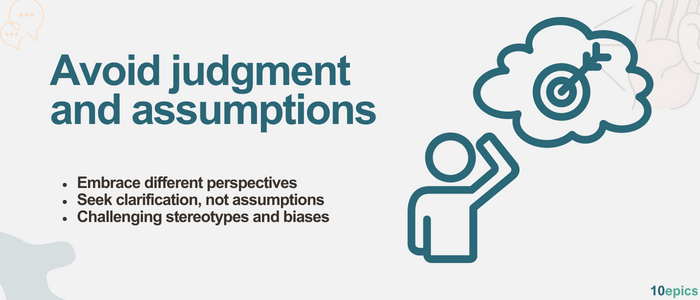
Step 13: Embrace different perspectives
Recognize that diversity enriches our understanding of the world. Instead of immediately dismissing opposing viewpoints, seek to understand the underlying reasons behind them.
Engage in respectful dialogue, asking clarifying questions to gain a deeper insight into others’ perspectives. By embracing diversity, we create a space where ideas can be explored, and personal growth can flourish.
Step 14: Seek clarification, not assumptions
Assumptions can hinder meaningful conversations. Instead of jumping to conclusions, seek clarification when you’re unsure about someone’s intent or meaning.
Ask for further explanation or context to avoid misinterpretations. By giving others the opportunity to clarify their thoughts, you promote clearer communication and avoid misunderstandings that can hinder genuine connection.
Step 15: Challenging stereotypes and biases
Challenge your own biases and actively embrace diversity. Recognize that stereotypes and preconceived notions can hinder genuine understanding.
Engage in conversations that challenge these biases, and be open to learning from others’ experiences. Actively seek to dismantle stereotypes and promote inclusivity in your conversations. By doing so, you create a space where everyone feels valued and understood.
Practice reflection and self-awareness
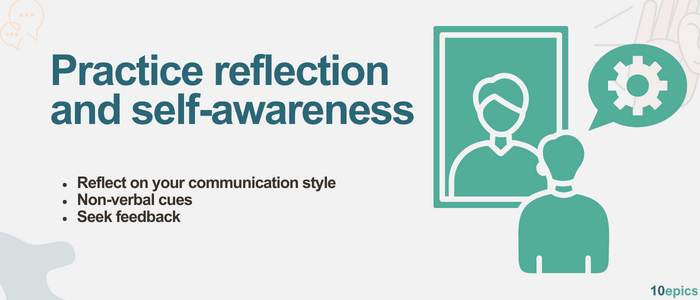
Step 16: Reflect on your communication style
Consider your strengths and areas for improvement. Are there any patterns or habits that may hinder effective communication?
Identifying these areas allows you to consciously work on them and enhance your conversational skills. Self-reflection is the first step towards growth as a communicator.
Step 17: Non-verbal cues
Pay attention to non-verbal cues, such as body language, facial expressions, and tone of voice.
These cues often convey more than the words spoken. Adjust your approach accordingly, adapting to the signals you receive from the speaker.
Being aware of non-verbal cues allows you to align your communication style with the emotional nuances of the conversation, fostering better understanding and connection.
Step 18: Seek feedback
Continuously seek feedback from others to gauge your effectiveness as a conversationalist.
Ask trusted friends or colleagues for their honest input on how you communicate. What are your strengths? Where can you improve?
Feedback provides valuable insights that can help you refine your conversational skills and develop self-awareness. Embrace feedback as an opportunity for growth and use it to enhance your future interactions.
Be present in the conversation
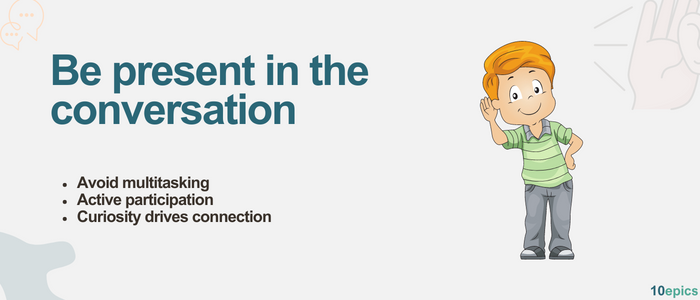
Step 19: Avoid multitasking
In our multitasking-driven world, it’s easy to lose focus during conversations.
Resist the urge to multitask and give your full attention to the conversation at hand.
Put away distractions and actively engage with the speaker. By being fully present, you demonstrate respect and create a space for meaningful connection to flourish.
Step 20: Active participation
Don’t be a passive listener—actively participate in the conversation.
Share your thoughts, experiences, and insights. Contribute to the dialogue by offering relevant examples or asking follow-up questions.
Your active participation not only enriches the conversation but also shows genuine interest and investment in the topic and the person you’re conversing with.
Step 21: Curiosity drives connection
Demonstrate genuine interest in the conversation and the person you’re engaging with.
Ask questions, listen attentively, and show curiosity about their thoughts and experiences. Engage with empathy, seeking to understand their perspective.
Practice effective storytelling

Step 22: Captivate your audience
Master the art of storytelling to make your conversations more captivating. Stories have a unique ability to engage and resonate with others.
Develop your storytelling skills by incorporating elements such as compelling narratives, intriguing characters, and a well-structured plot.
Step 23: Make it relatable
To make your point relatable, use vivid language that paints a clear picture in the minds of your listeners.
Choose descriptive words that evoke emotions and create a sensory experience. Additionally, share personal anecdotes and experiences that illustrate your message.
By connecting your ideas to real-life situations, you make them more tangible and relatable, fostering deeper understanding and connection.
Step 24: Evoke emotions
Craft narratives that evoke emotions and leave a lasting impression.
Share stories that tap into universal human experiences such as joy, sorrow, triumph, or resilience. Engage your audience’s emotions, and they will remember not only the story but also the connection they felt during the conversation.
Emotions create a powerful bond and make your conversations more impactful and memorable.
Practice patience and tolerance
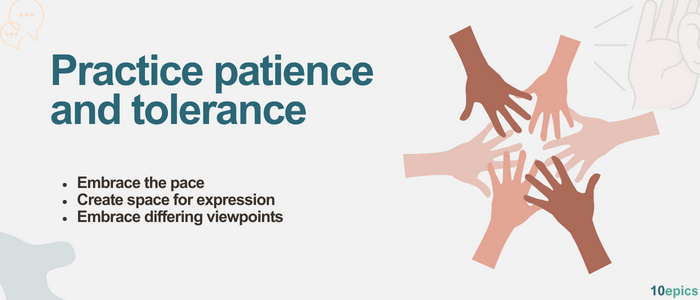
Step 25: Embrace the pace
Good conversations require patience, especially when it comes to the pace and flow.
Avoid rushing or trying to dominate the conversation. Instead, be patient and allow the conversation to unfold naturally. Give others the time and space to express themselves fully.
Practicing patience, you create an environment where everyone feels valued and heard.
Step 26: Create space for expression
Be attentive and actively listen to others without interrupting.
Avoid jumping in with your thoughts immediately after someone finishes speaking. Give a thoughtful pause, acknowledging their contribution, and allowing space for further exploration.
By providing this space, you foster an environment that encourages open dialogue and deeper connections.
Step 27: Embrace differing viewpoints
Tolerance is crucial in conversations that involve differing viewpoints.
Embrace healthy debates by respectfully engaging with alternative opinions.
Instead of dismissing or arguing, seek to understand the perspectives of others. Approach disagreements as opportunities for growth and learning.
Follow up and nurture relationships
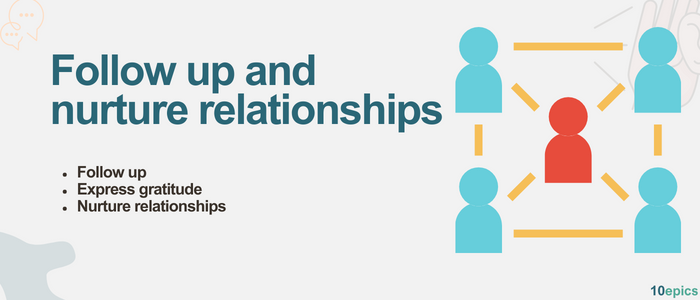
Step 28: Follow up
Don’t let the conversation end with its last words. Take the initiative to follow up after meaningful conversations.
Reach out to the person you spoke with to express your appreciation for the conversation and continue the connection. This simple act demonstrates your genuine interest and lays the foundation for a deeper and more enduring relationship.
Step 29: Express gratitude
Show gratitude and appreciation for the insights and perspectives shared during the conversation. Send a heartfelt message expressing how much you valued their input and how it has positively impacted you. Acknowledge the time and effort they invested in the conversation.
Step 30: Nurture relationships
To truly nurture relationships, it’s essential to maintain regular contact beyond the initial conversation. Keep the connection alive by reaching out periodically, whether through emails, calls, or meetups.
Show genuine interest in their lives, ask about their well-being, and share updates on your own experiences. Consistent communication reinforces the bond you’ve established and cultivates deeper connections that can evolve into long-lasting relationships.
Final thoughts
Embracing these 10 ways to have a better conversation not only enhances your communication skills but also enriches your relationships and fosters a deeper understanding of others. So, take these actionable steps to heart and witness the remarkable impact they can have on your interactions.